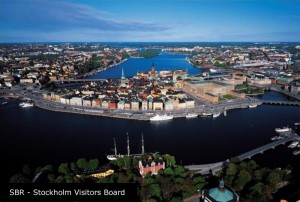Beautiful buildings, greenery, fresh air and proximity to the water are distinctive traits of Stockholm. It is a truly a city on the water, built on 14 islands connected by 57 bridges. The Stockholm Archipelago has more than 30,000 islands, islets and skerries.
Gamla Stan, the island where Stockholm began in 1252, is one of the largest and best preserved medieval city centres in Europe. All of Gamla Stan and the adjacent island of Riddarholmen are pedestrian-friendly and full of sights, attractions, restaurants, cafés, bars and places to shop. Narrow, winding cobblestone streets with buildings in soft shades of gold, ochre, pink and orange give Gamla Stan a unique character.
There are several beautiful churches and museums in Gamla Stan, including Sweden‟s national cathedral Storkykran (the Great Church) and the Nobel Museum. The mainly 18th century Italian Baroque-style Royal Palace has over 600 rooms and a daily changing of the guard. On Riddarholmen is the royal burial church, built as a Franciscan monastery for the so-called grey friars in the thirteenth century.
Author Stieg Larsson lived and worked for most of his life in Stockholm, Shortly before his early death, he got a publishing deal for a series of 10 books. He only lived to complete three. However, these three, The Girl with the Dragon Tattoo, The Girl Who Played with Fire and The Girl Who Kicked over the Hornet‟s Nest, became mega-hits in Sweden, sold millions of copies in English, French and German language translations and are now being turned into highly successful films.
Södermalm, where most of the action in his books takes place, is one of Stockholm‟s 14 islands and was a blue-collar area of the city, although it has been smartened up over the past 20 years. Highlights of a visit to Södermalm include Götgatan, the site of the office of journalist Mikael Blomkvist, the trilogy‟s main character and Kvarnen, a legendary drinking hall on Södermalm, frequented by Lisbeth Salander, another main character in the books.
Of course, a city does not live on buildings alone. The Östermalm Food Hall
dates from the 1880s and is full of counters and shelves of delicacies. There are also numerous restaurants and cafés offering traditional Swedish delicacies, with an emphasis on seafood and Swedish fare known as „husmanskost‟ or home cooking.
For those who want to experience modern urban Stockholm, there are two main districts to visit. The first is the area comprising the city centre, the entertainment hub of Stureplan, and the exclusive Östermalm district. Here are most of the large department stores, international brands, luxury shops, museums, galleries, nightclubs and gourmet restaurants. Second and more edgy are the Södermalm neighbourhood (of The Girl Who fame) and the area around Götgatan and „SoFo‟ (South of Folkungagatan), which have a blend of youthful, trendy, creative and often more bohemian fashion and design shops, plus restaurants, bars, cafés, markets and galleries.
For more ideas and information, see www.visitsweden.comor ask a friendly SWERMA member for personal recommendations.
 An ill managed 17th century risk
An ill managed 17th century risk
A visit to Stockholm gives the risk manager an opportunity to see the dramatic results of a poorly managed risk from the 17th century. The warship Vasa was top heavy, and overloaded with heavy calibre cannon to satisfy the pride of King Gustav II Adolf. She sank on her maiden voyage in 1628.
More than three centuries later, the Vasa was salvaged and for nearly half a century the ship was slowly and painstakingly restored to a state approaching her original glory. The Vasa is now on display at a specially built museum on the island of Djurgården which can be easily reached by tram, bus or metro or even on foot. It takes about 30 minutes to walk from the Central Station.
The Vasa Museum is open from 10.00 to 17.00 every day and until 20.00 on Wednesday.

